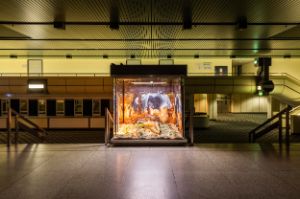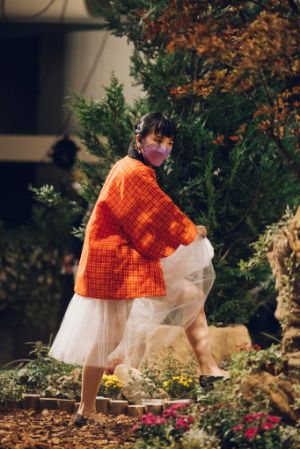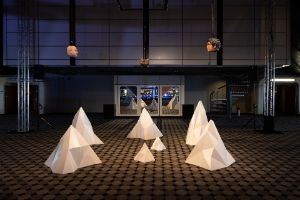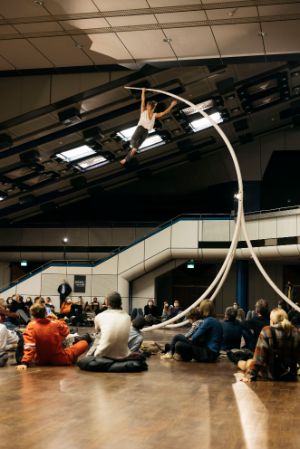The awareness that has arisen onsite connects itself with current discourses regarding cohabitation and can be transferred to other knowledge concepts – indigenous forms of knowledge and a radical media theory that proceeds from the technical implications of media on our thoughts and social behaviour. This project initiated by Thomas Oberender and curated by a team, follows the principle of simultaneity as it was intended in the architectural design by Ursulina Schüler-Witte and Ralf Schüler for the conference building. Visitors experience the gigantic building freely during their 3.5-hour visit and encounter temporary, either announced or spontaneously occurring, elements of the live art programme as well as permanently occurring screenings, concerts, and installations, within a shell that speaks for itself.
There is something mechanical in the paradox between the structural concrete and aluminium facade of the ICC, its outwardly closed typology, and its open space segments on the inside. All of the foyers communicate using visual axes and sound paths, and even the few rooms that can be closed will be open to each other during the event. The challenge that “The Sun Machine Is Coming Down” poses rests not only in the decentralisation of the art parcours of 1,000 people over 28,000 square metres, but also requires transmedial programming of the acoustically and visually overlapping positions. In this manner, an art format is created in which the space itself has the loudest voice and where the friction does not result in loss, but instead contains the promise of the experimental when we individually and gently invite artists who perform and illuminate so that the slumber of the ICC becomes the dream of another world from which can not be awakened.
The permanent programme includes screenings of the Julia Stoschek Collection shown in a loop in hall 1, the largest hall of the architecture: these works, created between 1978 and 2018, question the relationship of human beings to their own bodies and the position of the body in social structures. Be it the hyperreal avatar in the work of Ed Atkins or the dancer on the streets of Guangzhou in Cao Fei’s work, the creators of the selected video works are united by their faith in the power of resistance that is found in simple poetic gestures. Another hall that showcases a daily accessible programme is cinema hall 3 which provides insight into 70 years of Berliner Festspiele history on the occasion of its anniversary.
Using around 1,000 hours of film material from public and private archives, Thilo Fischer and David von Stein restored more than five hours of images and sound, and used them to assemble three video works that bring together news, discourse, and art. In addition, Thilo Fischer curates a film programme with recordings of extraordinary concerts, performances, actions, reports, and conversations, all in full length. Hall 2 is also programmed almost continuously, where music curator Martin Hossbach, with international and Berlin-based musicians, including Alexis Taylor, Nazanin Noori, The White Screen, Rosaceae, and Tegel Media, explore the compatibility of architecture and sound in the ICC with an expanded music programme of concerts and lecture performances.
The visual arts and acoustic installations in the lower foyer are time-based and yet permanently accessible: there, Markus Selg has filled ten glass cabinets with scenarios of future and archaic realities that flow into the large space in light choreographies and sonic worlds from the sound installations by Richard Janssen. In addition, the binary information and guidance system by the light artist Frank Oehring will be partially reactivated. He designed the system, which is inspired by the anatomy of human beings, for the architects in the 1970s. The most prominent feature of his work continues to be the “giant light sculpture” (the “brain”), the central ceiling sculpture at the core of the ICC machine.
Next to the sculpture, in the control room of the ICC, the asbestos fibres melted into cofalit plastic by Cyprien Gaillard question the chain of causation in human-nature-architecture-disposal and show how that which was once sought after suddenly became hazardous and can now be further processed to create resources. On the socio-political level, this change in consciousness is connected with a new way of thinking about how we deal with resources – sustainability is presented here in opposition to the “grey energy” of materials turned into the concrete of the ICC as an example of those architectures that are often created brutally through strategies of extraction and combustion, and which today require intelligent forms of reuse and the rededication of their purposes.
In this field, the Floating University Berlin, which has been active since 2018, has been shaping the discourse and has relocated its culture of conversation and ideas to the upper foyer of the ICC with a variety of talk formats, while a Spider Walk initiated by Studio Tomás Saraceno provides a look at lives pushed to the margins. The connection of knowledge with new needs can be heard here – a focus also placed by the artist Joulia Strauss with sculptures, installations, and discursive séances. These explore the further thinking of the media theory of her famous teacher Friedrich Kittler as she, together with additional companions, mediates the daily scheduled séances in hall 6 like journeys of the soul to Friedrich Kittler in honour of the tenth anniversary of his death.
Artificial and human intelligences come together in Monira Al Qadiri’s and Raed Yassin’s permanently accessible installation in the middle foyer with three kinetic busts whose AI voices tell of the artists’ bizarre experiences and dreams during the coronavirus pandemic. Ayaka Nakama also celebrates the boundary between the grotesque and the magical on the other side of the upper foyer in the botanical world of her four-hour solo “Freeway Dance” in which the earliest memories of dance she has collected with her friends and family become the embodiment of the dance itself.
An additional focus of our exorcism of the coronavirus is art from the fields of dance and circus, the latter curated by Wolfgang Hoffmann. Performances in the water cylinder and qigong on the forecourt of the ICC at the traffic junction Messedamm; repetitive circus exercises and dancing Styrofoam on the landmark protected 1970s carpet in the ICC lounge located at the rear of the foyer; balancing on a centring below the mechanically moveable grandstands system of hall 2 that weighs several tonnes: Chloé Moglia, Jörg Müller, Darragh McLoughlin and Andrea Salustri as well as Alexander Vantournhout, Grace Ellen Barkey. and Tino Sehgal, reinterpret the spatiality through counter gestures.
In their physically poetic and circensic narratives, the power of activating spaces as polytopias through movement becomes visible. Space is the basic condition of this narrative because it marks and defines that world from which the artistic parallel worlds literally move away from as alternatives. In doing so, they play with conditions that are constantly threatened by failure – flying, dreaming, emptiness, transformation, illusion, and transposition.
David Bowie celebrated the art of transformation. He was living in Berlin when the ICC was built. At the time of its opening in 1979, his promising lyrics “The Sun Machine is coming down. And we’re gonna have a party” were already ten years old. In 1969, during the last four minutes of his song “Memory of a Free Festival”, they bundled, almost like a mantra, the spirit of a time of physical closeness and wild parties that today, after 20 months of pandemic, feels so far away.
Dear disco, we will wait for you.









